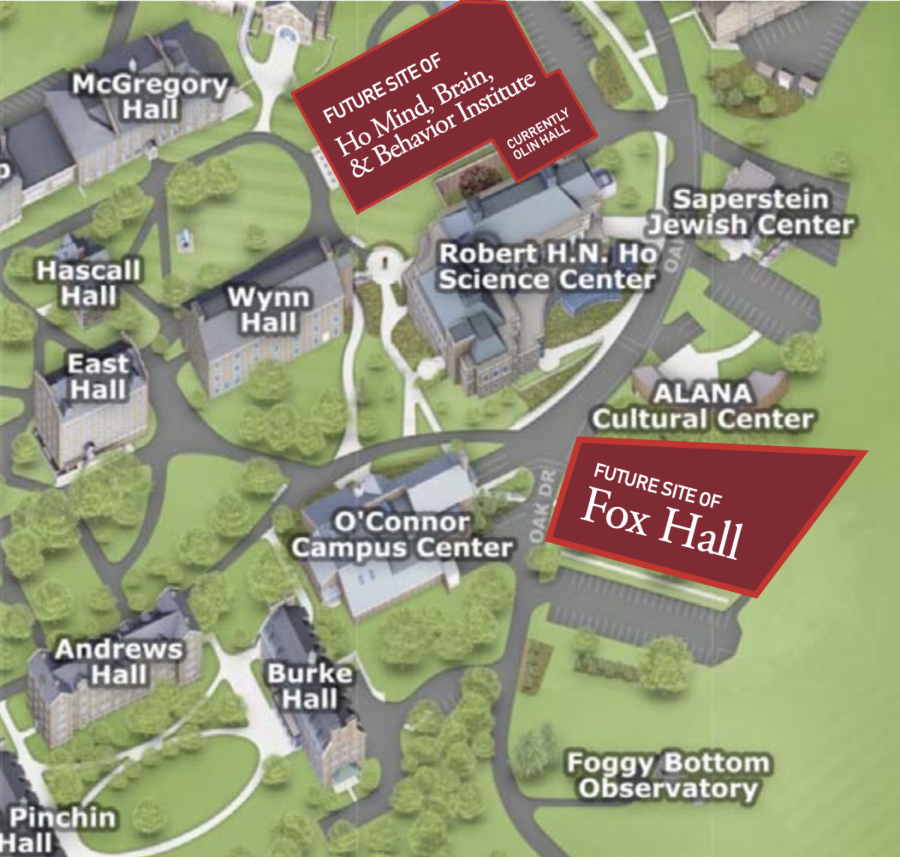Board of Trustees Returns to Campus, Allocates $37 Million to Third Century Plan Initiatives
LOOKING FORWARD, FROM ABOVE: Major construction approved by Board of Trustees at significant Upper Campus sites.
Colgate University’s Board of Trustees recently returned to campus for their Sept. 30 through Oct. 3 meeting, marking the group’s first in-person meeting on campus since the onset of the COVID-19 pandemic. The Oct. 11 University-wide email sent by Board Chair Michael J. Herling ’79 announced several new initiatives discussed at the meeting, made possible by major donations which total over $37 million. These initiatives include many projects announced in Colgate’s Third Century Plan, including infrastructural projects in the Middle Campus, renovations of the Dana Arts Center and Olin Hall, accocation of funds to the Colgate Commitment and First@Colgate program, new athletic facilities and the recently-announced construction of a fifth Residential Commons anchored by the new Fox Residence Hall.
According to University President Brian Casey, one of the Board’s primary agenda items was seeing the Colgate Commitment through, a pledge announced in June to provide full tuition to students with families income of $80,000 or less, and a percentage of income for those with incomes between $80,000 and $150,000. According to Herling’s email, the Board allocated $5.2 million in support of the Colgate Commitment, $2.5 million to endow the director of First@Colgate and First@Colgate programming, Diversity, Equity and Inclusion (DEI) programming and the Colgate Fund at their meeting.
“The Board over the last two years has been looking at all the things we want to undertake with the Third-Century Plan, which, by the way, has enormous non-building implications,” Casey said. “I always want to say […] the biggest change that’s happened so far is the Colgate Commitment, which isn’t a building […] I love that people want to support the buildings, but for me, it’s financial aid.”
The Third-Century Plan will include “not only capital projects but also programmatic needs,” according to the Oct. 11 email. For the Board, meeting on campus for the first time in two years provided enormous insight, according to Casey.
“It was extremely emotional [for the Board to be back on campus]” Casey said. “I did not anticipate how emotional it would be to have [Board members] come back, but more importantly we took the trustees on tours of Olin [Hall], tours of the Middle Campus and tours of residential life. We looked at apartments, we looked at themed houses and we looked at fraternities and sororities.”
Among the goals of the Third-Century Plan are several initiatives that include enriching residential and social life, Colgate’s Division I Athletics program and the development of Middle Campus. Other initiatives include attracting and supporting outstanding students, faculty and staff, and ensuring diversity, equity and inclusion. Among the weekend of meetings included an afternoon dedicated to conversation on diversity, equity and inclusion within the Board, led by outside consultants who have worked with a number of college and university boards, according to Casey.
“The Board, over the last about 18 months, said that [it] needed to look at its own DEI efforts, created a special committee on the Board, and then we looked at outside consultants who work with boards, mostly to see how boards operate,” Casey said. “Are all voices being heard? Are we taking in multiple perspectives? So this was the first time we were together, and in an unusually significant commitment, the entire afternoon of Friday was given over to a conversation about DEI with consultants.”
Since summer 2020, the Board has begun a number of DEI initiatives, including adding more trustees in order to “expand the diversity of the Board faster than normal turnover of trustees would allow, creating an Ad Hoc DEI Committee to help focus DEI issues across all the board committees, and developing a DEI board engagement program to strengthen the board’s governance and oversight functions,” according to the school-wide email.
“It’s easy for the Board to fall into patterns, so I’m very proud of [them] for taking this on […] they’re looking right at it and taking it on. I will say —and it’s not surprising — some of the conversations are difficult. What was helpful was having consultants help normalize the difficulty of the conversation. [The consultants] said, ‘You’re going to be having conversations that might be uncomfortable and that’s okay,’” Casey said.
Another initiative underway is the “Reid Reimagined” project. The current William A. Reid Athletic Center was built in 1959, when Colgate was an all-male institution with a student population of 1,500, one that does not fit the set of programs and competitive expectations of the university sport’s teams today, according to Vice President and Director of Athletics Nikki Moore.
“It will take many Colgate faithful to get involved through giving, to make this project become a reality,” Moore said. “However, when it is complete, and when we are able to realized the very thoughtful plans for the project that have been developed and will continue to develop over the course of the next year, it will provide an amazing venue not only for our varsity student-athletes, but for the entire campus and community as fans and as participants in programs and events throughout the year.”
Trustee Emeritus Robert Fox ’59 gave $10 million to replace Gate House and build Fox Hall, the first residential hall of the Fifth Residential Commons. This new addition will “foster the integration of living and learning on campus,” according to the University website. With many juniors and seniors living down the hill, sophomore Bela Hawkins agrees that having an additional residential commons will provide a greater sense of community.
“Socially, I think Colgate is more centered around off-campus housing and groups such as Greek life and sports teams,” Hawkins said. “I think adding a dorm and commons up the hill would create a space and community for students who might not want to be as involved in those organizations and help to bring a greater sense of inclusivity.”
The meetings concluded with a reception for the members of the Task Force on Reopening and the Task Force on Remote Learning, in order to acknowledge the efforts that have been put towards running a university during a global pandemic.

Sophie Mack is a senior from San Francisco, CA concentrating in art history and minoring in political science. She has previously served as a staff writer...











